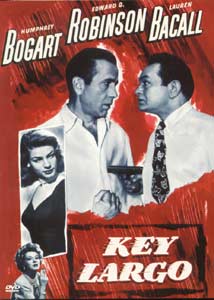Dir. John Huston
Starring: Humphrey Bogart, Edward G. Robinson,
Lauren Bacall, Lionel Barrymore
Summer in the Florida
Keys . Off season. The fans in the hotel lobby turn slowly,
circulating what little air there is. Men’s shirts stick sweatily to their
backs. And there’s a storm coming.
Out here in the coral islets of the Keys there
is no reason to visit in summer. It’s a place where it’s hotter in the night
than the daytime, hotter when it is raining than when it isn’t. Old Man
Temple Temple
He is not the only visitor to Key Largo however. Sharks swim in these waters. McCloud
finds the hotel already has guests. Here for the fishing, they say. But that
hardly explains the tension in the air, the pointed glances that pass between
the men, the forced bonhomie. As the hurricane closes in and the Temples US Cuba
And it is this group that find themselves
trapped in the hotel while the hurricane rages outside. A cripple, a woman,
a mobster, his four heavies, his drunken moll, and Bogart’s ex-soldier.
This is what it comes down to: a moral choice. Is McCloud willing to risk his
life in order to stop Rocco? The gangster asks him that flat out, hands him a
gun. Just the two of them, point-blank range. Will McCloud pull the trigger
with Rocco’s gun aimed straight at his belly? And McCloud’s decision? “One Rocco more or less isn’t worth
dying for.”
 |
| "We're gonna steal all your towels..." Bogie starts to reconsider his Tripadvisor rating |
Only Bogart could pull that off. Bogart the
reluctant soldier, sickened by the destruction he has seen during the war. “I had hopes once, but I gave them
up”, he says. “Hopes for
what?” “A world in which there’s no place for Johnny Rocco.” Temple Temple
Yet, of course, Bogart becomes the hero in the
end. He is spurred on by the death of the deputy and two local Seminole Indians
and by Rocco’s mistreatment of his devoted and drunken lover Gaye (Claire
Trevor, who won an Oscar for her performance as the down-at-heel showgirl). He
is spurred on by the realisation that if the Roccos of this world come out on
top all the sacrifices of the war were for naught. And he is spurred on by
the change in the way that Nora now looks at him. He agrees to sail the
mobsters back to Cuba once
their business in Florida America
The character of Frank McCloud is a perfect
fit for Humphrey Bogart. McCloud is a wise-cracking street-smart survivor who has left idealism
behind and learned to look out for number one. But, as in Casablanca Chinatown .
It clearly has theatrical origins – the action is confined to the hotel’s lobby
for most of the film, heightening the claustrophobia. The details of the
action, the names of the characters, and the ending (a shoot out on the boat
heading to Cuba
What have I learnt about Florida
Not to visit in the summer. I’m not sure I
could handle the muggy, stultifying heat. Or the risk of hurricanes – Temple Cuba
Can we go there?
In the film they talk about the quality of the
fishing around Key Largo . Largo Key Largo ).
The bus is stopped in the opening scene on Seven Mile Bridge
There is no Largo Hotel however; the bulk of
the film was shot on the production lot at Warner Bros studios in Burbank , California
Overall Rating: 3/5

No comments:
Post a Comment